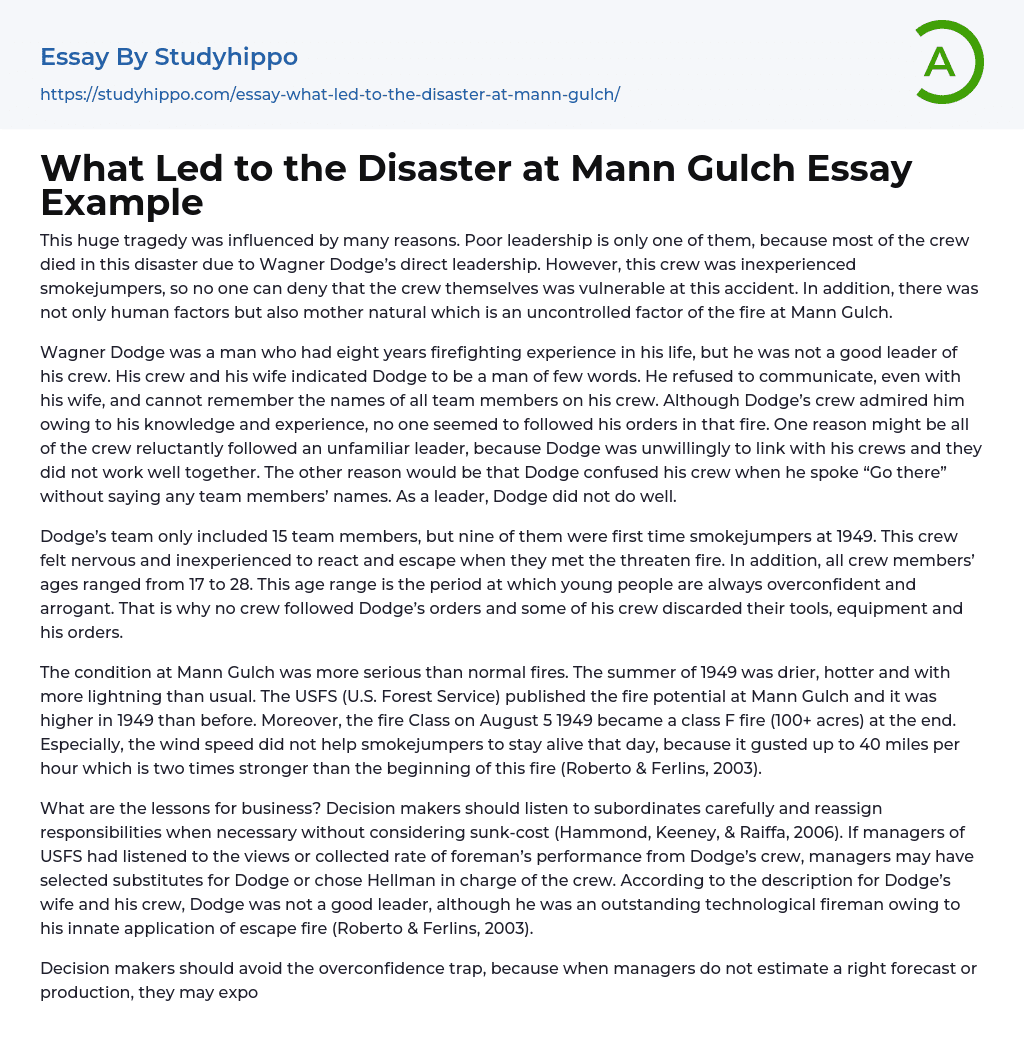This huge tragedy was influenced by many reasons. Poor leadership is only one of them, because most of the crew died in this disaster due to Wagner Dodge’s direct leadership. However, this crew was inexperienced smokejumpers, so no one can deny that the crew themselves was vulnerable at this accident. In addition, there was not only human factors but also mother natural which is an uncontrolled factor of the fire at Mann Gulch.
Wagner Dodge was a man who had eight years firefighting experience in his life, but he was not a good leader of his crew. His crew and his wife indicated Dodge to be a man of few words. He refused to communicate, even with his wife, and cannot remember the names of all team members on his crew. Although Dodge’s crew admired him owing to his knowledg
...e and experience, no one seemed to followed his orders in that fire. One reason might be all of the crew reluctantly followed an unfamiliar leader, because Dodge was unwillingly to link with his crews and they did not work well together. The other reason would be that Dodge confused his crew when he spoke “Go there” without saying any team members’ names. As a leader, Dodge did not do well.
Dodge’s team only included 15 team members, but nine of them were first time smokejumpers at 1949. This crew felt nervous and inexperienced to react and escape when they met the threaten fire. In addition, all crew members’ ages ranged from 17 to 28. This age range is the period at which young people are always overconfident and arrogant. That is why no crew followed Dodge’s orders
and some of his crew discarded their tools, equipment and his orders.
The condition at Mann Gulch was more serious than normal fires. The summer of 1949 was drier, hotter and with more lightning than usual. The USFS (U.S. Forest Service) published the fire potential at Mann Gulch and it was higher in 1949 than before. Moreover, the fire Class on August 5 1949 became a class F fire (100+ acres) at the end. Especially, the wind speed did not help smokejumpers to stay alive that day, because it gusted up to 40 miles per hour which is two times stronger than the beginning of this fire (Roberto & Ferlins, 2003).
What are the lessons for business? Decision makers should listen to subordinates carefully and reassign responsibilities when necessary without considering sunk-cost (Hammond, Keeney, & Raiffa, 2006). If managers of USFS had listened to the views or collected rate of foreman’s performance from Dodge’s crew, managers may have selected substitutes for Dodge or chose Hellman in charge of the crew. According to the description for Dodge’s wife and his crew, Dodge was not a good leader, although he was an outstanding technological fireman owing to his innate application of escape fire (Roberto & Ferlins, 2003).
Decision makers should avoid the overconfidence trap, because when managers do not estimate a right forecast or production, they may expose themselves to more risk than they realize. Decision making flow is an effective way to avoid being fixed by initial estimate; to do this start by considering the extremes, and the low and high ends of the possible range of value (Hammond, Keeney, & Raiffa, 2006). In the fire at Mann Gulch,
crews discarded their tools and equipment before Dodge’s order. This activity was irresponsible and dangerous, because they did not consider any result of lacking tools for firefighting and their safety of life (Roberto & Ferlins, 2003).
In business, managers should create high-performing teams, because in such teams, team members always perform effectively, acquire new skills, perspectives, and behaviors by changing circumstances and feel more satisfied than a general team (A Team Primer). In Dodge’s team, his crew did not learn much firefighting knowledge from him and most of them complained about Dodge’s characteristic (Roberto & Ferlins, 2003).
Based on strategic lens and culture lens, business organizations should design an appropriate structure for their daily operation and should always train their employees to follow the enterprise culture and rules (Applying the Three Lenses). This is also what USFS did after the fire at Mann Gulch. USFS tried to educate young and cocky smokejumpers to follow the orders of their superiors, otherwise they would be dismissed and “relieved of duty” (Roberto & Ferlins, 2003).
In addition, team members need to work together for a period of time to get team experience (A Team Primer). The crew of Dodge was reluctant to follow him and Dodge did not remember his crew members’ names. They might alive today if they had worked or trained together for longer period.
- Business Law essays
- Contract essays
- Consumer Protection essays
- Property essays
- Ownership essays
- Agreement essays
- Common Law essays
- Contract Law essays
- Justice essays
- Security essays
- Tort Law essays
- United States Constitution essays
- Crime essays
- Lawsuit essays
- Treaty essays
- Family Law essays
- Marijuana Legalization essays
- Constitution essays
- War on Drugs essays
- Court essays
- Jury essays
- Police essays
- Protection essays
- Community Policing essays
- Criminal Law essays
- Judge essays
- Lawyer essays
- Employment Law essays
- Copyright Infringement essays
- Injustice essays
- Intellectual Property essays
- Breach Of Contract essays
- Jurisprudence essays
- Social Injustice essays
- Juvenile Justice essays
- Internet Privacy essays
- Cyber Security essays
- Bill Of Rights essays
- Civil Liberties essays
- First Amendment To The United States Constitution essays
- Fourth Amendment To The United States Constitution essays
- Second amendment essays
- Animal Cruelty essays
- Law Enforcement essays
- Juvenile Justice System essays
- Surveillance essays
- Forensic Science essays
- Crime Prevention essays
- Criminal Justice essays
- Criminology essays




